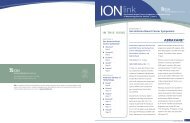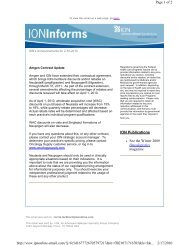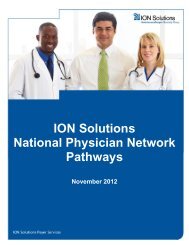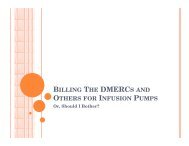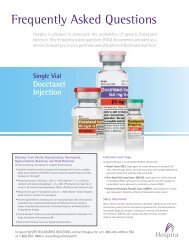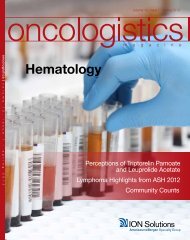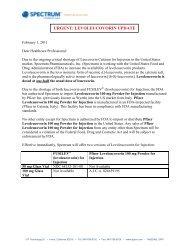First Quarter 2008 - Issues in Hematology - ION Solutions
First Quarter 2008 - Issues in Hematology - ION Solutions
First Quarter 2008 - Issues in Hematology - ION Solutions
- No tags were found...
You also want an ePaper? Increase the reach of your titles
YUMPU automatically turns print PDFs into web optimized ePapers that Google loves.
oncologistics drug updateIn the placebo-controlled Phase III SHARP trial,therapy with Nexavar resulted <strong>in</strong> a significant 44%survival improvement <strong>in</strong> HCC patients, and is thus theonly agent that has demonstrated a survival benefit<strong>in</strong> this malignancy.Nexavar Inhibits Both Tumor CellProliferation and AngiogenesisTwo processes that are important for HCC tumor growthare angiogenesis and signal<strong>in</strong>g through the Raf/mitogenactivatedprote<strong>in</strong> (MAP)/extracellular signal-regulatedk<strong>in</strong>ase (ERK) k<strong>in</strong>ase (MEK)/ERK (Raf/MEK/ERK) cascade.Nexavar exerts its antitumor effects by target<strong>in</strong>g multiplek<strong>in</strong>ases <strong>in</strong>volved <strong>in</strong> both of these processes (SeeFigure 2). 5,6 The Raf/MEK/ERK pathway, which relayssignals from cell surface receptors to the nucleus, playskey roles <strong>in</strong> govern<strong>in</strong>g cell proliferation, differentiation, andsurvival, and has been shown to be activated <strong>in</strong> HCC and5, 7-10other solid tumors.Nexavar targets the Raf/MEK/ERK pathway at thelevel of the ser<strong>in</strong>e-threon<strong>in</strong>e k<strong>in</strong>ase Raf, result<strong>in</strong>g <strong>in</strong>reduced tumor cell proliferation. 5,6 Furthermore, HCCtumors are highly angiogenic, 11 and <strong>in</strong>-vitro modelsshow that Nexavar reduces HCC tumor angiogenesisby target<strong>in</strong>g multiple receptor tyros<strong>in</strong>e k<strong>in</strong>ases, <strong>in</strong>clud<strong>in</strong>gvascular endothelial growth factor receptor (VEGFR)-2,VEGFR-3, platelet-derived growth factor-betaFigure 2Tumor CellEndothelial Cell or PericyteEGF/HGFAutocr<strong>in</strong>e LoopParacr<strong>in</strong>eStimulationPDGF-ßVEGFPDGFR-ßRAFMEKERKRASNexavarHIF-2NucleusApoptosisMitochondriaEGF/HGFPDGFVEGF }ProliferationSurvivalMitochondriaApoptosisRAFMEKERKNucleusRASNexavarVEGFR-2Angiogenesis:DifferentationProliferationMigrationTubule FormationMechanism of action of Nexavar <strong>in</strong> prevent<strong>in</strong>g tumor growth. Nexavar targets multiple tyros<strong>in</strong>e k<strong>in</strong>ases <strong>in</strong> tumor cells,endothelial cells, and pericytes, result<strong>in</strong>g <strong>in</strong> reduced tumor cell proliferation and angiogenesis. 5oncologistics 4



